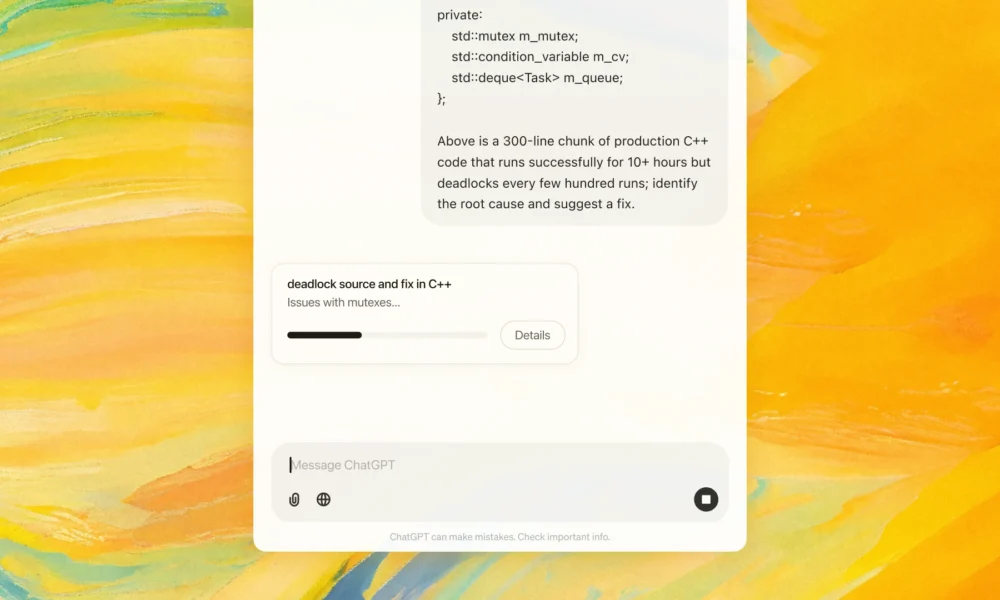OpenAI just rolled out what they are calling their “smartest model in the world.” It comes with a $200 monthly price tag and promises to think harder, work longer, and solve more complex problems than anything we have seen before. But in a world where AI announcements seem to drop every week, this one deserves a closer look.
The new ChatGPT Pro, powered by the o1 model, is not just another regular upgrade. While the regular ChatGPT has become the Swiss Army knife of AI tools, this new offering is more like specialized surgical equipment – incredibly powerful, but not for everyone.
What o1 Really Brings to the Table
Let us cut through the hype and look at what makes o1 different. The model shows some impressive numbers, but what matters is where these improvements actually make a difference.
In real-world testing, o1 shows improvements in three key areas:
- Deep Technical Problem-Solving: The model achieves 50% accuracy on AIME 2024 mathematics competition problems – up from 37% in previous versions. But more importantly, it maintains this performance consistently. When tested for reliability (getting the right answer 4 out of 4 times), o1 pro mode significantly outperforms its predecessors.
- Scientific Reasoning: In PhD-level science questions, o1 demonstrates a 74% success rate, with even more impressive gains in consistency. What is interesting is how this translates to real research applications – we are seeing researchers using it to design sophisticated biological experiments.
- Programming and Technical Analysis: Perhaps most tellingly, o1 achieves a 62% pass rate on advanced programming challenges, showing particular strength in complex, multi-step problem-solving. However – and this is crucial – it actually struggles with simpler, iterative tasks that require back-and-forth conversation.
Image: OpenAI
The real innovation here is not just raw performance – it is reliability. When the model needs to think harder about a problem, it actually does, taking more time to process and validate its responses.
But there is a kicker: all this extra “thinking” comes with trade-offs. The model is notably slower, sometimes requiring significantly more time to generate responses. And for many day-to-day tasks, this extra horsepower is not just unnecessary – it might actually be counterproductive.
What Happens with This Much Computing Power?
Let’s talk about what actually happens when you supercharge an AI with more computing power. Forget the marketing speak – what we are seeing with o1 is fascinating because it changes how we think about AI assistance entirely.
Think of it like the difference between a quick chat with a colleague versus a deep strategy session. The standard AI models are great for those quick chats – they are snappy, helpful, and get the job done. But o1? It is like having a senior expert who takes their time, thinks things through, and sometimes comes back with insights you had not even considered.
What is actually revolutionary about this approach?
- Deeper “Thinking”: When you give an AI model more time to “think,” it does not just think longer – it thinks differently. It explores multiple angles and considers edge cases. This is why researchers are finding it particularly valuable for experimental design and hypothesis generation.
- Reliability: Here is something nobody is talking about: consistency might be o1’s real superpower. While other models might nail a complex problem once and fail the next three times, o1 shows remarkable consistency in its high-level reasoning. For professionals working on critical problems, this reliability factor is a big deal.
The Smart Buyer’s Guide to AI Power Tools
We should have an honest conversation about that $200 price tag. Is it really worth it? Well, that depends entirely on how you think about AI assistance in your workflow.
Interestingly, the people who might benefit most from o1 are not necessarily those working on the most complex problems – they are the ones working on problems where being wrong is extremely costly. Unless you are in specific situations like this, that extra power might actually just slow you down.
Using o1 effectively requires a fundamental shift in how you approach AI interaction:
- Depth Over Speed
- Instead of rapid back-and-forth exchanges, think of it as crafting well-thought-out research queries
- Plan for longer response times but expect more comprehensive analysis
- Quality Over Quantity
- Focus on complex, high-value problems
- Use standard models for routine tasks
- Strategic Deployment
- Combine o1 with other AI tools for an optimized workflow
- Save the heavy computational power for where it matters most
o1 is not trying to be everything to everyone. Instead, it is pushing us to think more strategically about how we use AI tools. Maybe the real innovation here is not just the technology but the way it is making us rethink our approach to AI assistance.
Think of your AI toolkit like a professional kitchen. Yes, you could use the industrial-grade equipment for everything, but master chefs know exactly when to use the fancy sous vide machine and when a simple pan will do the job better.
Before jumping into that $200 subscription, try this: Keep a log of your AI interactions for a week. Mark which ones genuinely needed deeper thinking versus quick responses. This will tell you more about whether you need o1 than any benchmark ever could.
What excites me most about o1 is not what it can do today, but what it tells us about tomorrow. We are watching AI evolve, moving from a tool that tries to do everything to one that knows exactly what it is best at.
Whether you jump on the o1 bandwagon or not, one thing is certain: The way we think about and use AI is evolving, and that is something worth paying attention to.




